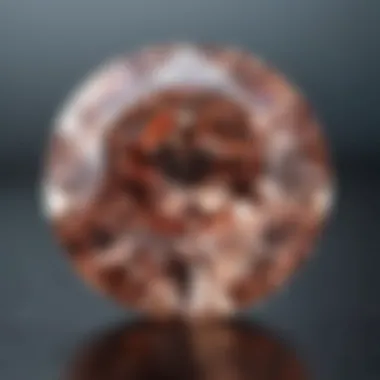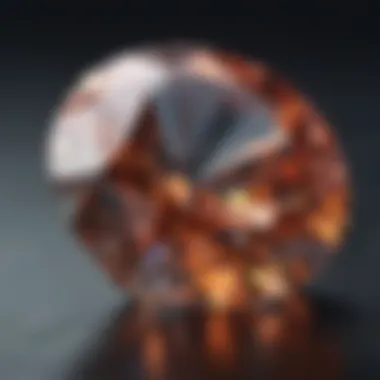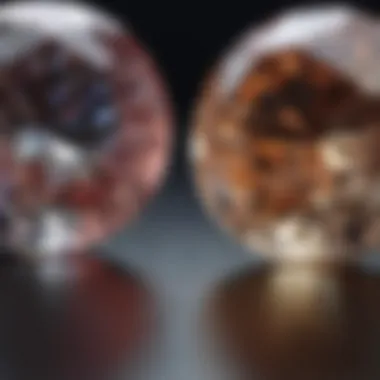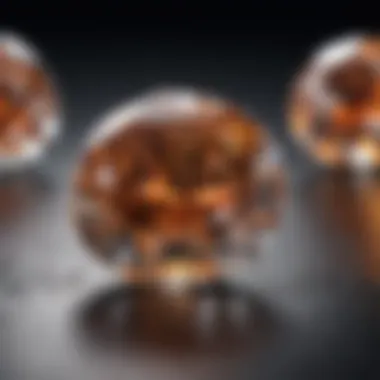Comparative Analysis of VVS Diamonds and VS Diamonds


Intro
Diamonds have long captivated the human imagination. Their remarkable brilliance and rarity position them at the pinnacle of gemstones. Among these splendid gems, VVS and VS diamonds take notable spots in the grading spectrum. The letters signify the clarity categories of these diamonds, indicating their quality in relation to internal imperfections.
Very Very Slightly Included (VVS) diamonds portray an extraordinary level of purity—flecks or internal blemishes that might exist are virtually impossible to detect even under magnification. In contrast, Very Slightly Included (VS) diamonds have slightly more noticeable inclusions, but still retain an overall high clarity. This comparative analysis will dive into the depths of these two classifications, offering insight into their visual characteristics, and influencing factors on value for collectors and enthusiasts alike.
Through this exploration, one will gain a clearer view of how clarity impacts a diamond's appearance and market prominence, shedding light on the intricacies that accompany the world of luxury gemstones.
Prolusion to Diamond Grading
When diving into the world of diamonds, understanding the grading system becomes essential. This isn't just about selecting a pretty piece; it's about making an informed decision that resonates with personal taste and financial investment. Within this section, we will break down the key elements that influence diamond quality and why they matter. Grasping these fundamentals lays the groundwork for appreciating the differences between VVS and VS diamonds, the focus of this article.
Overview of the Four Cs
The Four Cs of diamonds – Cut, Color, Clarity, and Carat Weight – are the pillars upon which the value and appeal of a diamond stand. Each aspect plays a unique role in shaping a diamond's overall beauty and, by extension, its price.
Cut
Cut isn't just about shape; it's more about how light dances within a diamond. A well-cut diamond can appear more brilliant due to its ability to reflect light. Brightness, fire, and scintillation are all part of this equation. A diamond cut to proper proportions allows it to emit a captivating sparkle, which is a major reason why cut is often deemed the most crucial of the Four Cs. A diamond that’s expertly cut makes all the difference, elevating even modest stones in terms of aesthetic appeal, whereas a poorly cut piece may appear dull regardless of its other qualities.
Color
Color grading ranges from colorless to shades of yellow or brown. The less color a diamond has, the higher its value typically is, especially in the eyes of many collectors. However, some find warmth appealing, and yellow diamonds can bring a unique character. The subtle hues in diamonds can affect their price significantly, highlighting the importance of personal preference in this aspect. A strikingly colored diamond may stand out—making a statement that resonates with individual taste.
Clarity
Clarity reflects how clear or flawed a diamond is, with inclusions being the tiny imperfections that can affect its look. The fewer inclusions present, the more valuable the diamond is perceived to be. VVS diamonds boast very very slight inclusions that are often difficult to detect, offering almost flawless appearance while VS diamonds have slight inclusions that may be visible under magnification but are still considered of good quality. This discussion is central to understanding the comparative analysis later in the article.
Carat Weight
The carat weight measures how much a diamond weighs. While larger diamonds may capture attention, weight does not always correlate with brilliance. A smaller, high-quality diamond could outshine a larger, low-quality stone. Here, budget comes into play; buyers often have to make tough choices about size versus quality. The unique feature of diamonds at different carat weights compounds their appeal, making selection based on budget and desired appearance crucial.
Importance of Clarity in Diamonds
Clarity plays a fundamental role in determining a diamond's allure. As we explore VVS and VS diamonds, it’s evident that clarity impacts not just aesthetic appreciation but also investment value. Each clarity grade tells a story, describing the journey a diamond has taken through formation and reflection. This element is not merely a technical characteristic; it stands as a testament to the diamond’s purity and elegance, serving as a guiding principle for discerning buyers who seek a blend of beauty and investment potential.
Understanding Clarity Grades
When it comes to diamonds, clarity is essential. This section breaks down what clarity grades mean, particularly focusing on the VVS and VS classifications. Understanding clarity grades offers insights not just into the aesthetic value of diamonds, but also their monetary worth. Clarity can influence how a diamond sparkles and how its unique characteristics come to light. In this way, clarity becomes a window into the diamond's story.
What Does VVS Mean?
Definition and Criteria
VVS stands for "Very Very Slightly Included." This term is used in diamond grading to describe stones that bear miniscule inclusions, which are almost invisible to the untrained eye. The criteria for this designation are stringent; it means the diamond has tiny imperfections that can only be detected under high magnification, typically at 10x. The major advantage here is that VVS diamonds tend to have superior brilliance due to fewer internal flaws.


Many consider VVS diamonds an excellent choice because they strike a balance between high quality and relatively reasonable prices compared to Flawless diamonds. Most buyers prioritize clarity, especially if they want a ring that shines bright without noticeable blemishes. However, some might argue that the difference between VVS and even higher clarity grades is often so subtle that it may not justify the elevated price tag.
Visual Characteristics
Visual characteristics of VVS diamonds are quite compelling. Under a jeweler's loupe, one may see the slightest imperfections, but to the naked eye? Almost impossible. This invisibility lends VVS diamonds an ethereal quality, allowing them to dazzle in all lighting conditions.
Buyers appreciate how VVS diamonds retain their beauty while commanding respect among connoisseurs. However, even with the brilliance, some opt for lower clarity grades, like VS or SI, for better value. After all, who wouldn't want a beautiful piece without draining the bank?
Exploring VS Diamonds
Definition and Criteria
VS actually stands for "Very Slightly Included." A VS diamond has inclusions that are slightly more noticeable than those in a VVS diamond, but they still require magnification to be identified, usually at 10x. Many buyers find VS diamonds to be the sweet spot in the diamond market. They provide a great value for clarity without sacrificing overall appearance.
This clarity grade is particularly appealing for those looking for a balance of beauty and budget. While a VS diamond may have some small imperfections, they are often less than what would make a notable difference when worn. This means buyers can snag a lovely diamond without feeling like they are compromising too much.
Visual Characteristics
Visually, VS diamonds maintain a vibrant sparkle and brilliance similar to VVS diamonds. Although they might have slight imperfections, often these inclusions are not readily noticeable, even in certain lights. This characteristic contributes positively to the overall aesthetic appeal, especially when someone wears their diamond as jewelry.
Some might say that VS diamonds offer great value, providing a semblance of luxury without the hefty price tag of their VVS counterparts. The challenge often lies in ensuring that inclusions don’t detract from the lovely qualities for which diamonds are adored. Thus, when selecting a VS diamond, scrutinizing the specific inclusions via the certification report becomes crucial, delivering clarity not only in grading but also in expectations for visual beauty.
Comparison of VVS and VS Diamonds
Understanding the differences between VVS (Very Very Slightly Included) and VS (Very Slightly Included) diamonds is crucial for anyone engaged in the diamond market, whether as a buyer, collector, or enthusiast. This comparison not only sheds light on clarity grades but also illuminates how these distinctions affect value, aesthetic appeal, and purchasing choices.
Clarity Differences
The clarity of diamonds, which refers to the presence of inclusions and blemishes, serves as a primary factor in determining their quality. VVS diamonds contain minute inclusions that are nearly invisible even under 10x magnification, while VS diamonds have slightly more noticeable inclusions, still difficult to see with the naked eye. The distinction may seem subtle, but it can significantly influence both the price and desirability of these diamonds.
Visual Perceptions
Magnification Analysis
Magnification plays a pivotal role in assessing and appreciating the clarity of diamonds. 10x magnification is the industry standard for grading diamonds, allowing gemologists to evaluate inclusions with precision. VVS diamonds, under magnification, show little to no visible flaws, which establishes their high market value. In contrast, VS diamonds will present inclusions that, despite being minor, may still be observed upon close inspection.
When buyers consider diamonds for purchase, magnification analysis can help them make informed decisions. Understanding how inclusion visibility varies between VVS and VS diamonds aids collectors in selecting the right piece that aligns with their expectations. One unique aspect of this analysis is that it confirms the exceptional quality of VVS diamonds, reinforcing their reputation in the luxury market. However, it can also create a barrier for some potential buyers who seek immediate visual clarity without delving into complex grading criteria.
Appearance to the Naked Eye
While magnification analysis provides thorough insight into clarity, the appearance to the naked eye remains paramount for buyers who may not be equipped with magnifying tools. VVS diamonds typically look flawless, providing an exceptional sparkle and brilliance that captures attention. On the other hand, VS diamonds might present with slight inclusions that can occasionally be noticeable under certain lighting or angles but do not significantly detract from their overall beauty.
This aspect fuels the debate among buyers; for some, the invisible qualities of VVS diamonds justify the premium pricing, while others might find the subtle inclusions in VS diamonds acceptable for their budget. The visual appeal of both types can vary based on individual preferences and expectations, creating a rich tapestry of choice in the marketplace.
Value and Pricing
Market Trends


Market trends in diamond pricing directly relate to clarity ratings and can fluctuate based on consumer preferences. Currently, VVS diamonds are in high demand due to their perceived superior quality, which can cause their prices to soar compared to VS diamonds. However, market insights reveal that VS diamonds, while slightly less expensive, often appeal to a broader demographic, providing an affordable option for those wishing to invest in quality gems without breaking the bank.
Buyers should consider market trends closely. The popularity of VVS diamonds may lead to increased prices, whereas the wider acceptance of VS diamonds may create opportunities for finding deals in the market.
Investment Potential
Investing in diamonds is not just about selecting gems with the best clarity but also considering their long-term value retention. VVS diamonds typically offer better investment potential due to their rarity and high demand. However, it is essential to note that VS diamonds can also retain value effectively, especially if they possess other desirable qualities, such as ideal cut and color.
Thus, potential buyers should weigh their options: do they prefer investing in a VVS diamond with its premium price, or do they opt for a VS diamond that balances affordability with aesthetic appeal? Each option has its own merits, making it vital for collectors and investors to evaluate their personal preferences alongside market conditions.
Factors Influencing Diamond Choices
When it comes to selecting diamonds, factors influencing diamond choices are pivotal. Understanding these elements is essential not only for personal satisfaction but also for making sound financial investments. The right choice can mean the difference between being thrilled with your purchase and feeling a tinge of regret years down the line.
A few key considerations come into play:
- Personal preferences: Each buyer has unique tastes, which significantly shape their choices. Some may lean towards a specific clarity grade, while others may be drawn to a particular design or cut. Knowing one’s own style is crucial.
- Budget: Money can shape a buyer’s decision more than any other factor. Whether you’re looking for something that dazzles without breaking the bank or aiming for a top-tier investment piece, budget sets the stage for available options. It's important to recognize what you can comfortably afford, so you won't be left feeling like you've overspent.
- Occasion and purpose: The reason behind the purchase also plays a vital role. Are you buying an engagement ring or just treating yourself? The significance of the occasion can dictate what characteristics are prioritized in the selection process, including clarity, cut, and even carat weight.
Buyer Preferences and Budget
Buyer preferences and budget intertwine in a delicate dance. A person might adore the sparkle of a VVS diamond but find that their financial situation allows for a more modest VS stone.
It’s normal to face such dilemmas, as personal dreams don’t always align with monetary constraints. Factors such as:
- Visual impact: VVS diamonds offer remarkable clarity, which can bring forth breathtaking brilliance. Buyers enamored with perfection may focus on these stones even when they stretch their budget.
- Value retention: Investing in diamonds can also be about long-term gains. VS diamonds, while slightly less clear, often provide good value for money, especially if your budget is tight but you wish to have a grand gemstone in your collection.
In the end, making a decision involves balancing desires and financial realities while keeping in mind that both diamond categories—VVS and VS—can offer stunning options.
Occasion and Purpose
Every diamond tells a story. Consequently, occasion and purpose determine not only the choice of diamond but how it’s perceived by the recipient.
For engagements, you might opt for a diamond with a higher clarity grade, as it symbolizes commitment and love. Here are some common occasions that influence choices:
- Engagements: This is arguably the most significant event for your diamond purchase. Couples often favor higher clarity diamonds to represent the lifelong bond they are about to forge. Every detail matters, and a VVS diamond can underscore the importance and beauty of the moment.
- Anniversaries: As years pass, many people desire to commemorate milestones. A VS diamond might be perfect for this purpose, offering good visibility without requiring top-tier clarity, while also being budget-friendly.
- Fashion Statements: Sometimes, people simply want a diamond to showcase their personal style. This can lead to the selection of shapes or cuts rather than clarity alone. In these cases, buyers may feel comfortable settling for a VS grade since other aspects may take the spotlight.
One key takeaway from considering occasion and purpose is that diamonds should not only be seen as objects of luxury but as reflections of emotion and intention. Your choice should thoughtfully match the meaning behind the occasion, ensuring that the diamond fits beautifully into your narrative.
The Role of Certification
In the intricate world of diamonds, the role of certification can't be overstated. It acts like a badge of trust, ensuring buyers that what they pay for matches the clarity and quality declared. Especially when distinguishing between VVS and VS diamonds, certification is crucial. Without it, you might be guessing in the dark about a stone's real worth.
Certification bodies not only assess the diamonds but also provide a documented account of their characteristics. This aids buyers in making informed choices, essentially adding an extra layer of security to their purchase. Moreover, it helps establish market standards. Therefore, understanding the ins and outs of certification is vital to navigating the diamond marketplace.
Understanding Certification Bodies
GIA


The Gemological Institute of America, commonly known as GIA, is perhaps the most recognized certification entity in the diamond world. What sets GIA apart is its stringent grading standards and commitment to unbiased evaluations. Buyers frequently flock to GIA-certified diamonds because they can trust that each stone has undergone thorough scrutiny.
GIA's grading system provides a detailed report that specifies clarity, cut, color, and carat weight. This report is like a diamond’s resume, showcasing its credentials. One notable feature of GIA evaluations is that they incorporate advanced technology to ensure accurate assessments. Nevertheless, this thorough process can also lead to higher prices as diamonds that are GIA-certified are often seen as premium investments.
AGS
The American Gem Society, or AGS, also contributes significantly to diamond certification. AGS is known for its own precise grading scale, especially when it comes to cut quality. This body provides comprehensive reports that gauge the light performance of a diamond, which is essential for understanding how a diamond sparkles.
Another reason AGS is popular is its consumer protection stance, requiring its members to adhere to ethical practices. What’s uniquely beneficial about AGS is its focus on cut quality as an essential factor in a diamond’s overall beauty. However, while AGS is esteemed, it’s sometimes perceived as less prestigious than GIA, which could impact resale value down the line.
Evaluating Certification Reports
Clarity Assessment
Clarity assessment is a cornerstone of the certification process, particularly when differentiating between VVS and VS diamonds. This process meticulously evaluates the presence of inclusions and blemishes under magnification. A vital aspect of clarity assessment is that it doesn’t just label a diamond; it provides insights into how inclusion-free a stone might be and how that affects its visual appeal.
When a diamond is graded, buyers receive a clear understanding of what to expect. For example, a VVS diamond may show tiny inclusions under extremely magnified views, while a VS diamond might reveal its imperfections to the naked eye when viewed closely. Thus, clarity assessments offer real benefits to buyers focusing on quality and beauty.
Significance of Documentation
Documentation cannot be underestimated when discussing diamonds. It serves as an essential reference for buyers, allowing for a clear and concise understanding of a diamond's attributes. The significance of this documentation lies in its ability to affirm the value of a diamond over the years. A well-documented diamond is less prone to disputes over quality, especially regarding resale or insurance evaluations.
Having a certificate is like having a passport; it tells potential buyers where the diamond originates and its journey through various hands. This aspect of certification can influence buyer decisions heavily, as clear and robust documentation often signals reliability. In a market filled with options, having well-documented details about VVS and VS diamonds can steer a buyer confidently toward making a purchase.
"Certification offers clarity in a world where sparkle often leads to confusion."
End and Recommendations
The conclusion of this exploration into VVS and VS diamonds wraps up the intricate web of clarity grading, aesthetic appeal, and financial implications surrounding these glittering gems. The distinctions between VVS and VS diamonds are not just academic; they're pivotal for anyone making a purchase. Understanding where each grade lies within the hierarchy of diamond quality can yield significant benefits, whether for personal enjoyment or as an investment.
When we talk about clarity, we touch on a fundamental aspect of a diamond's value. VVS diamonds, being of a higher clarity rating, often command premium prices. However, the price differential may not always align with visible differences to the naked eye. This brings us to the importance of personal needs and budget when selecting diamonds.
Buyers often fall into the trap of thinking that they must secure a VVS diamond to ensure their investment retains or increases in value. However, many folks find VS diamonds offer an excellent balance between quality and price, often appearing flawless in casual settings.
Therefore, the recommendations for potential buyers include:
- Evaluate Personal Preferences: Think about what factors matter most to you—whether it’s clarity, size, or budget.
- Consider Practicality: If the diamond will be worn regularly, a VS option may serve quite well without compromising appearance.
- Explore the Market Trend: Keeping an eye on market shifts will prepare you better for making informed purchases.
Simply put, before making a pick, understanding the broader landscape of diamond choices ensures that buyers are not merely swept along by trends but are making decisions rooted in clarity, value, and personal satisfaction.
Summary of Findings
In summarizing the findings from our comparisons between VVS and VS diamonds, several key points emerge.
- Clarity Ratings: VVS diamonds have only minute inclusions, almost invisible to even experienced gemologists with a 10x magnification, while VS diamonds contain small inclusions that can be tough to spot with the naked eye.
- Visual Appeal: Both clarity grades can exhibit remarkable sparkle and brilliance, making them highly desirable for different types of buyers.
- Investment Potential: While VVS diamonds do have a higher resale value in many cases, VS diamonds can also represent a shrewd investment for those seeking value without the extravagant price tag.
These findings underscore the idea that both categories have their virtues and can fulfill different buyer needs effectively.
Guidance for Potential Buyers
For those looking to step into the sparkling world of diamonds, here are some considerations we recommend:
- Perform Your Homework: Research is your best ally when it comes to understanding the differences between diamond grades. Websites like Wikipedia offer foundational knowledge on this subject.
- Set a Budget: Determine how much you're willing to spend before you shop. Knowing your limits will help avoid the temptation to overspend, especially in a market that can be overwhelming.
- Seek Certification: Don't overlook the importance of certified diamonds. Understanding reports from established authorities like GIA or AGS can offer invaluable insights into what you're buying.
- Seek Out Reputable Dealers: Building trust with your jeweler can be key. A knowledgeable and honest dealer can guide your purchase, ensuring you get exactly the diamond that fits your needs.
Taking these steps can empower you to make more intelligent choices, blending clarity, personal desire, and investment resilience into the perfect diamond.







